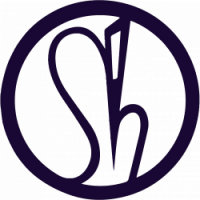The collection of photograms entitled ‘Panvirus” will be completed shortly. I have a few very large pieces to complete which should include 4 large screens (2m x 1m), 1 maybe 2 large square pieces (fertile crescent) and an installation (a photogrammed table set for dinner on cloth) entitled war table.
While making this work, I have been asking the question ‘ How does this work relate to my VR Practice ?I considered how I use light in VR and then began to ask in what way does lighting aid player navigation in virtual reality (VR) and also potentially open world navigation ? ’
This is an extension of the research I conducted 2018-2020 when first using the unity game engine to produce virtual worlds. I became interested in wayfinding and navigation in real world and virtual settings. I experimented with game engine lighting and other visual methods used to imply affordances to the ‘player’ so as to indicate access routes and pathways, considered landmarks, mental modelling and other world navigation tools.
I am beginning to bring together these two processes, Light in Cyanotype print/photogram making and Virtual Reality (VR) Navigation. I am doing this by examining bird migration. I first began thinking about migrating birds when I produced a work entitled ‘Nightingale’ for my cousin Rebecca. She has an exceptional musical ability and I wanted to create an illustration of the beautiful whistle she makes as I’ve never heard anyone else be able to produce this beautiful sound. One day I happened to meet a fledgling nightingale on my garden path and the concept for the work slowly emerged from this.
I began considering where does the nightingale go in the winter time, how does it migrate ? Now, this is where things got really interesting…
I discovered that birds have a magnetic sensory in between their eyes by which they can sense the earths global magnetic force. I researched this further in Nature research papers. It is understood that this only functions in the presence of blue light. It is through the use of this internal mechanism that birds can navigate vast spans of ocean without seeing any landmarks. Other insects and animals seem to have this ability to a greater of lesser degree.
This led to asking if humans have the same sensitivity to magnetic force. I found research, conducted over 10 years (2000 – 2010) in which the results concluded that humans did indeed have this function however the results could not be replicated by other researcher in the field. This meant that it could not be verified, the enquiry faded into oblivion and the original researcher basically said ‘ bugger you’.. and walked away (we can all sympathise here!) However, in 2016 researchers built a box which excluded interference from general magnetic fields in which starved male human test subject were shown plates of food on screen. The test subjects blind folded, and whilst on a rotating chair, they were asked to point to the place where the food had been… the test concluded that there is a high probability that humans do indeed have magnetic perception and can use this as an internal compass to locate food.
This is interesting because the modern world of advanced technology is built on magnetic sensors. In every phone & mobile device magnets help to pinpoint its location on the surface of the planet. The planet itself is in fact one enormous magnet. Essentially, magnetosensory perception only works in the presence of blue light . This blue light is produced in the chemical reaction where an iron ion is lost in the process, during cyanotype print making.
Also, there is increasing concern that bird migration can be disrupted by land lighting over cities and on coastlines. Bird migration can be affected by changing environmental conditions such as unusually large storms/cyclones insect availability etc and as such, is being observed in relation to climate change. Birds are also it seems, essential for seed dispersal which is another essential factor of bio diversification, wild birds literally rewild nature.
So, out of this process I would like to produce a small set of bird illustrations, I say that they will be illustrations as my thinking is that each image will tell a fragment from a story. It would be interesting to present these in the spirit of ‘Ergodic’ literature in which there is no linearity to the story itself as the observer can place these fragments together to form their own stories. The illustration may be animated or at least form the basis of animation within a ‘game’ story structure. It is likely this developed will be documented on my commercial blog and portfolio at some point.
I also intend to explore light further in VR as a continuation of my own independent research in virtual reality. This activity will follow on from the Cyanotype photograms produced for Panvirus. I hope to include aspects of light, shadows and effects will be introduced in the Panvirus virtual gallery which has already been set up in Unity Engine to produce a 360 image and very basic app prototype (which will also be posted to my commercial blog and portfolio in the near future).
Next :
Experimental
‘Fertile Crescent” 60cm x 60cm Cyanotype photogram.
‘Consumption’ Cyanotype screen
‘Suspension’ Cyanotype screen
‘Reconnection’ Cyanotype screen
‘War Table’ installation – welland valley.
Commercial
Panvirus 360 image (self-directed)
Panvirus VR prototype(self-directed)
‘Automatic Writing’ book cover (self-directed)
‘And they followed the moon to find home’ cynanotype print/photogram illustration (self-directed)
Continue light experiments and magnetic sensory navigation research.























































































